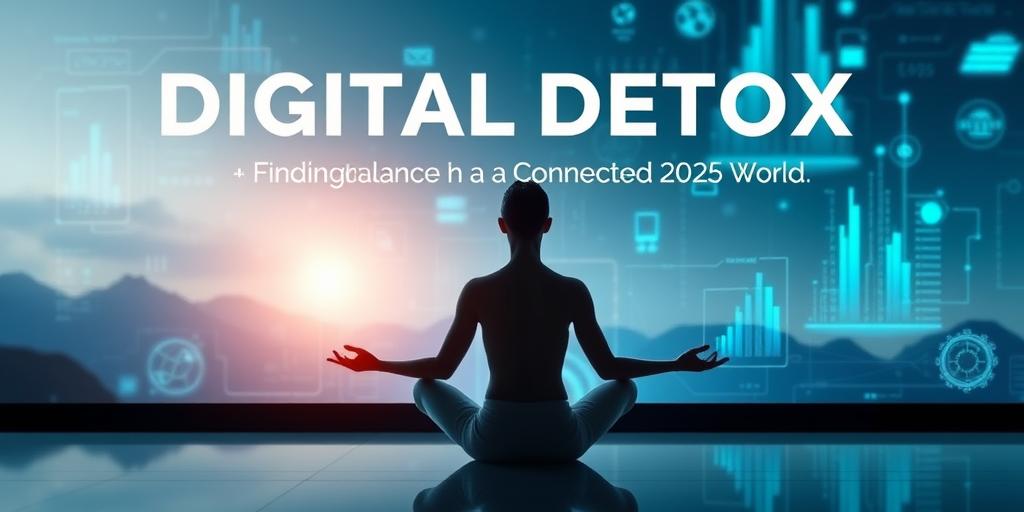In 2025, digital connectivity is more pervasive than ever. Smartphones, smart homes, and wearable tech are deeply integrated into our daily routines. While these advancements offer convenience and efficiency, they also present challenges in maintaining a healthy balance. This article explores the concept of a digital detox, its importance, and practical strategies for finding balance in our hyper-connected world.
Understanding the Digital Landscape in 2025:
The digital landscape has evolved significantly. We now live in an era where augmented reality (AR) and virtual reality (VR) are becoming commonplace. Social media platforms are more immersive, and the Internet of Things (IoT) connects countless devices, creating a seamless but potentially overwhelming digital experience.
The Need for a Digital Detox:
Constantly being plugged in can lead to several adverse effects:
- Increased Stress and Anxiety: The constant stream of notifications and information can trigger stress responses.
- Sleep Disturbances: Blue light emitted from screens can interfere with melatonin production, disrupting sleep patterns.
- Reduced Focus and Productivity: Multitasking and constant interruptions can diminish concentration and overall productivity.
- Social Isolation: Excessive online interaction can lead to decreased face-to-face communication, fostering feelings of loneliness.
- Eye Strain and Physical Discomfort: Prolonged screen time can cause eye strain, headaches, and musculoskeletal issues.
Strategies for a Successful Digital Detox:
A digital detox doesn’t necessarily mean complete disconnection. It’s about consciously managing your digital consumption.
- Set Boundaries: Establish specific times of the day when you disconnect from digital devices. For example, no phones during meals or before bed.
- Create Tech-Free Zones: Designate areas in your home, like the bedroom, as tech-free zones.
- Limit Social Media Usage: Use apps or browser extensions to track and limit your time on social media platforms.
- Turn Off Notifications: Disable non-essential notifications to reduce distractions.
- Practice Mindfulness: Engage in activities that promote mindfulness and relaxation, such as meditation or yoga.
- Reconnect with Nature: Spend time outdoors, away from screens. Nature has a calming effect and can help reduce stress.
- Engage in Hobbies: Rediscover hobbies or activities you enjoy that don’t involve digital devices, such as reading, painting, or playing a musical instrument.
- Plan Digital-Free Days: Schedule entire days where you intentionally disconnect from all digital devices.
- Use Technology Mindfully: When using technology, be intentional about your purpose and avoid mindless scrolling.
- Seek Support: Talk to friends, family, or a therapist about your digital habits and seek support in making positive changes.
The Benefits of a Digital Detox:
Implementing a digital detox can lead to numerous benefits:
- Reduced Stress and Anxiety: Disconnecting from the constant stimulation of the digital world can lower stress levels.
- Improved Sleep: Reducing screen time before bed can improve sleep quality.
- Enhanced Focus and Productivity: Minimizing distractions can increase concentration and productivity.
- Stronger Relationships: Spending more time engaging in face-to-face interactions can strengthen relationships.
- Increased Self-Awareness: Disconnecting from digital devices allows you to reconnect with yourself and your surroundings.
- Improved Physical Health: Reducing screen time can alleviate eye strain and musculoskeletal issues.
Tools and Apps to Aid Your Digital Detox:
Several apps and tools can help you monitor and manage your digital usage:
- Freedom: Blocks distracting websites and apps.
- Forest: Helps you stay focused by planting a virtual tree that grows as long as you stay off your phone.
- Digital Wellbeing (Android): Provides insights into your digital habits and allows you to set app timers.
- Moment: Tracks your screen time and offers coaching to help you reduce it.
Conclusion:
In our increasingly connected world of 2025, finding balance is essential for our well-being. A digital detox is not about rejecting technology altogether but rather about consciously managing our digital consumption and prioritizing our mental, emotional, and physical health. By setting boundaries, practicing mindfulness, and rediscovering offline activities, we can harness the benefits of technology without being overwhelmed by it. Embrace the opportunity to disconnect and reconnect with yourself and the world around you.
